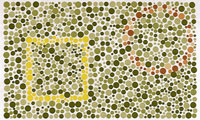
Image source: colorvisiontesting.com
I am always amazed at the fact that things we see in color are actually a sensation "felt." They are a sensory impression that is a physiological reaction to the wavelengths of light received by the color receptors in our retina. We give that sensation, "what we see" a name, like lavender, green or teal but that's a name we've learned when feeling that sensation. Scientists call this a "mechanism" which is a way of bypassing the complexity of what's going on.
A color's name has been agreed across languages and, for many, for 100's of years. That's amazing. What's also amazing is that the majority of humans see "color" in the same way. For example, the name of the background color of the stop sign we've been taught is called "red" though it could be rosso in Italian, rojo in Spanish or aka 赤 in Japanese. We all agree.
Color is also emotional and cultural. People use it to tell stories, identify differences and through film, art and print create a palette of feelings. People and animals use color to be better at what they do. Athletes use it as a tool and, if you happen to be frugivorous (fruit eating) like some new world monkeys, you would be well served to be trichromatic. Some female monkeys (platyrrhine species) are trichromatic and may be particularly advantaged because they can detect yellow and orange fruits hidden in a sea of green leaves. Up to two-thirds of all monkeys in this species and every male is dichromatic and therefore lacks the ability to distinguish the fruit by color. It's not clear whether those females are more successful at finding food but seems to me that she is better armed seeing more colors than less when leading a frugivorous life style. (From, A perspective on color vision in platyrrhine monkeys, Gerald H. Jacobs Neuroscience Research Institute and Department of Psychology, University of California, Santa Barbara, CA 93106, 31 July 1997).
Let me recommend...
Color Vision Deficiency, A Concise Tutorial for Optometry and Ophthalmology from Richmond Products
This booklet is an invaluable reference for the optician that wants a better understanding of color vision and more importantly color deficiency. This booklet starts with, "Many times each day we use our color vision ability to discern and evaluate objects, signs, situations and other phenomena, often concerning matters of safety, work or pleasure, and observation in general. Use of color is considerably more prevalent in today's information-oriented environment with the advent of color computer displays and printers, for example. With age, color vision often deteriorates at a faster rate than visual acuity."
What about people unable to see the same colors as others?
There are some 13 million Americans (about 12 million men, 8 percent of the population and 1.2 million women, 0.4 percent) that don't see color like all others. They are often called "color blind." However, colorblind is misleading because it implies a total lack of color sensitivity. Color blindness is possible but is extremely rare (the condition is called rod monochromatism).
Most people are more accurately described as color deficient, and the technical term is "anomalous trichromacy". They have a lack of sensitivity to certain wavelengths in the way that their eyes "see" color and therefore the way in which the brain interprets color.
Recently, EnChroma, a new company in Berkeley California developed and began to market a sunglass, called the EnChroma Cx that can correct color outdoors for about 85 percent of those that are tested as color deficient. Using a many-layered, tuned spectrally, series of dielectric coatings on a special color filter glass, color deficient individuals can see color. An individual named DS, a Protan (red-green deficient individual) said, "Everything is just more vivid and more clear. It is like if you take a television and you turn the color knob up and it just all gets brighter... I'm able to see colors in the way that they should be seen. And, I am realizing that the way I have been seeing them is just a more dull and constricted version of color, and now it just exploded." (See more on the EnChroma site here.) For disclosure, this author has been working with EnChroma as a consultant to develop an Rx version of their lens technology.
Nano-Precision Attenuation
Enchroma Cx lenses work by blocking specific wavelengths that compromise the color sensitivity of an individual. Using a proprietary computer method, the application of dielectric coatings can be tuned, by individual wavelength, to produce a specific spectrum of colors that results in a digital color boost.
The ability of the EnChroma technology to tune and transform color perception for specific individuals, and for various applications, invites a number of interesting questions. 1. How can lenses be tuned to help the color deficient i.e., adults and especially school age children with color deficiencies? 2. What are the possible opportunities for outdoor lenses that can help individuals see colors that were never seen before or enhance color contrast so much that there is an improvement in stereopsis? 3. For those with normal color vision but reduced transmission, for example seniors with reduced lens, media or retinal clarity, will they see improvements to depth perception and therefore have enhanced mobility? 4. Is there a plasticity effect i.e., can individuals that wear these lenses daily, over months, develop any increased color sensitivity? 5. For athletes, golfers in particular, can lenses be tuned to enhance the environment? To understand the opportunity, one must understand color perception, normal color vision, color vision deficiencies and the way that sunglasses can enhance the world visually.
Color Perception
The macula contains about 7 million cones, special color sensitive retinal receptors. Cones are stimulated by the visible spectrum, electromagnetic radiation from about 400 nm to 700 nm. There are three kinds of cones, each sensitive to a range of wavelengths and intensities of light. These three types of cone sensitivities, short, medium and long, define our vision as "trichromatic."
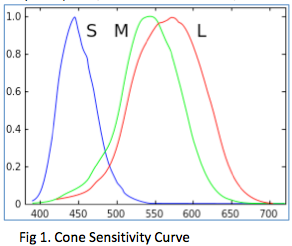
Color is the result of stimulating the three cone types. Requiring medium to high light brightness, the receptors of each of the three types of cones peak in the short (S) range (420-440nm), middle (M) range (530-540nm) and long (L) range (560-580nm) of wavelengths. This combination of sensitivities allows all the colors of the rainbow. Fig 1. Illustrates cone sensitivity curves. As you can see, the sensitivity curves overlap each other.
Any wavelength of light from 420nm to 660nm will produce a unique set of responses that combines all three-cone types. For the outer range of very short or very long wavelengths, a single receptor is mostly stimulated and fired. Technically, wavelengths <420nm stimulate the S cone but still cause some stimulation of the L-cone (red) which is why deep blue appears slightly violet. Some colors are called "unique" because they are the result of the peak of the sensitivity of the cone or of two overlapping sensitivities. They are unique blue around 450nm, unique green around 525nm, unique yellow 580nm, unique red >630. However, the ability to discriminate colors across the spectrum is not uniform everywhere. There are some regions that have higher sensitivities; others have lower sensitivities. In addition, color sensitivity depends on illumination.
Do we see all colors as they actually are? Do we agree on the names of all colors, or see them as the majority of people see them? It's actually pretty close but color may be slightly different for each of us as a result of what's received by the cone receptors, illumination, perception, and our own personal visual development and age. That makes for slight differences.
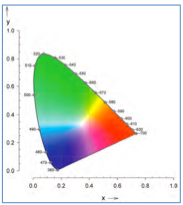
For example, as the sun's intensity changes during the day, color also changes but our eyes adjust pupil size for chromatic consistency so that all colors still look the same. Now add a pair of sunglasses of normal tint, color is shifted depending on the filter color. The colors seen are skewed, noticeable at first, a surprise for the brain but after a short time the skewed difference is ignored however colors remain shifted. A good way to explain that is by a chromaticity map (Fig at right). A tinted or polarized lens shifts the white point altering the tones of any variety of colors, more reddish from brown tints, green or blue shifts from gray-green or gray-blue lenses, etc.
As we said, color is the result of reflection of an illuminated object, a reflection of the pigment. When white light is reflected from a pigmented object, we see the color of only those wavelengths reflected for that pigment. And, as the illumination and shadow varies, the color seen also varies. That also means that that same object in the dark has "no" color. Reflected color in shades and tones amongst other objects of color helps us describe shape and location for perspective, three-dimensionality and our movement through and around those objects.
As we age, the crystalline lens becomes yellower and therefore absorbs the shorter blue wavelengths. That also makes for differences in the way we perceive color. In addition, while the rods are extremely sensitive to small amounts of light (night vision), they are not specialized to receive and transmit color. The subtle shades we see are dependent on illumination, which would be different during daylight, at dusk and then at night. So, depending on what time asked during the day, we would describe the colors of objects differently.
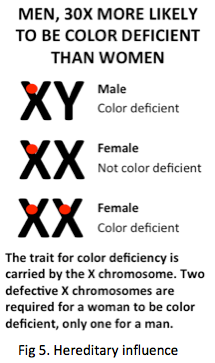
Color Vision Deficiency (CVD)
As stated, there are more than 13 million people in the US with color vision deficiency (CVD). There are two ways that a person becomes color deficient. The majority of CVD individuals are born with it i.e., it's hereditary. The other is by disease or from toxic substances that can create a color vision deficiency problem.
Most people born with CVD are men, (8 percent of men or, 1 in 12). That's a result of a defect on the X chromosome that affects the spectral sensitivity of the M-cone and L-cone receptors. Since men have only one X chromosome, and if there is the defect on the X chromosome for color vision, the man will be color deficient. A woman's gene coding comes from two X chromosomes and the defect has to be present on both X's to produce the condition (Fig 5). That's rare (about 0.4 percent). However, it is estimated that about 28 percent of women carry the defect most commonly affecting the cone's sensitivities to the green portion of the spectrum. As a result, a percent of male children will typically have a problem with the perception of green. The condition is almost always binocular when inherited. To date, there is no known cure.
Some definitions are in order. Trichromats have three functioning color receptor cones, Dichromats, two and Monochromats, one. An anomaly in color vision is a variance in the way that one sees color for a cone type. For example, an anomalous Protan has a problem with reds. That problem could be mild, medium or strong. If mild or medium then the person is an anomalous trichromat, meaning they still have three functional cone types, but the function is not as good as normal. If strong then this person is defined as a Protanope and generally these people are considered dichromats characterized by a missing L-cone (or equivalently, their M-cone and L-cones are indistinguishable). For green, the person is an anomalous Deutan unless strong, then called a Deuteranope, for blue, an anomalous Tritan, if strong a Tritanope.
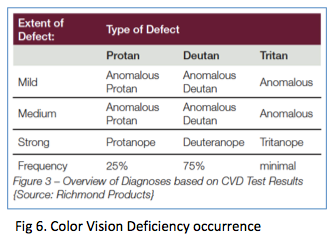
Defining the kind of anomaly in a color range requires testing to understand the colors and their shades that are the problem. Green deficiencies are the most common as seen in Fig 6, which describe the types of color deficiency defects. EnChroma estimates that about 1/2 of protans are protanopes, and about 1/6th of deutans are deuteranopes. The EnChroma Cx only works for anomalous trichromacy, which fortunately means that most people with CVD are candidates.
Red-green CVD is the most common type of CVD. Red-green CVD is caused by an X-chromosome-linked genetic anomaly. Blue-yellow CVD is the next most common type, which is prevalent in between about 3-6 percent of the population, depending on age and environmental factors. Blue-yellow CVD is acquired from chemical exposure and/or aging of the eye.

Except in the most rare cases (e.g., rod monochromats, less than 0.001 percent of people), people with CVD can see colors. However, with CVD it is more difficult than normal to differentiate between shades of certain colors—for example, between green and yellow, green and brown, red and brown, pink and grey, and/or between purple and blue. Fig. 7 illustrates the color change for a Protanope.
A person with CVD is often slower and/or more likely to misidentify colors. This is why people with CVD are restricted from participating in certain occupations, such as commercial and military aviation, where fast response time to colored signals is needed. The consequences of a mistake could be catastrophic. For example, it is estimated that there is a 30 percent reduction in reaction time for a Protanope when identifying color-coded information. That's equivalent to a 0.05-0.08 percent blood alcohol level, approaching the legal limit.
Therefore, the sunglass opportunity for those that don't usually see the full array of colors is large. The ability to produce a spectral boost for the CVD individual can be a significant change to their life. It's the understanding of the tunability of the EnChroma dielectric coating technology to create spectral filtering that makes EnChroma lenses work so well. Unlike any other sunglass lens, they selectively and significantly change the ratio of wavelengths (colors) that are received by the eye's color receptors. It is like they surprise the brain into seeing new vibrancy of colors that were always there but have been masked.
It's very hard to describe to one that has normal color vision the reaction of a CVD person when they do see color. This recent boingboing.net post (May 2014) describes Kelly Kittell's reaction. He wrote, "EnChroma CX Receptor colorblind-correcting sunglasses arrived with the following warning: When first trying on the lens, the unusual appearance of colors may be visually distracting. "It's a bit of an understatement. The first time I saw brick red I was so overwhelmed I stopped cold. Purple and lavender, where have you been all my life?" Read more here.
Part Two of this paper will discuss the technology of the EnChroma lenses and their application for both the color vision deficient individual as well as the variety of lenses that have been developed for those with normal color vision.










